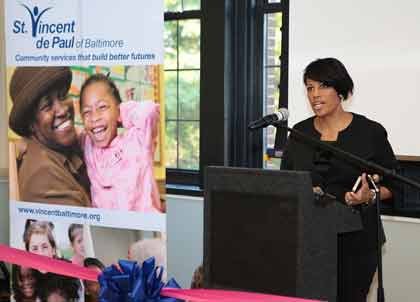Mayor Stephanie Rawlings-Blake joined St. Vincent de Paul of Baltimore and other community leaders at the grand opening event for the newly renovated Sarah’s Hope family shelter in the Sandtown-Winchester neighborhood of Baltimore City.
The $8 million project doubled the shelter’s capacity to 150 beds to meet increased demands, making it the city’s largest homeless shelter for families. The renovations created family style living units, expanded space for improved services, and added a new early childhood center for homeless children operated by PACT. The new Sarah’s Hope allows Baltimore City to meet the requirements of the federal HEARTH act by accommodating families with older adolescent males, intact families, and families headed by single fathers. Sarah’s Hope’s intensive and comprehensive services minimize the length of time families are homeless by helping families overcome barriers to housing, increase their self-sufficiency, and quickly return to permanent housing. The Sarah’s Hope capital project was supported by the City of Baltimore, the State of Maryland, The Harry and Jeanette Weinberg Foundation, the late Willard Hackerman, and other local foundations, corporations, and individuals.
“This is a huge leap forward in our effort to provide resources that will have a positive impact on families struggling with poverty and homelessness in Baltimore City,” said Mayor Rawlings-Blake. “The completion of this project not only allows St. Vincent de Paul to better serve the families who come through Sarah’s Hope with more accommodating living arrangements and the comprehensive services they need to improve their lives, but it offers a wonderful recreation facility for the families in the adjacent Sandtown-Winchester community.”
Families who are homeless, nationally and in Baltimore, represent about one third of the homeless population, and have been the fastest growing segment of the homeless population in recent years. While homelessness for anyone is tragic, the challenges faced by homeless families far exceed those of individuals. Homeless families often face many barriers to housing arising from physical and mental health needs; substance abuse; domestic violence; poor credit; lack of education; low wages; and unemployment.
Homeless children experience emotional and behavioral problems at triple the rate of non-homeless children, including high rates of depression, anxiety, low self-esteem, and stress. Children who have been homeless are four times more likely to have developmental problems and/or educational delays, and twice as likely to have learning disabilities. The longer a family is homeless, the more difficult it becomes for that family to regain permanent housing and self-sufficiency, and the greater the negative impact for children. For these reasons, the focus of Sarah’s Hope is to minimize the length of time that families are homeless.
Operated by St. Vincent de Paul of Baltimore since 2008, Sarah’s Hope is located in the Sandtown-Winchester neighborhood of Baltimore City. Prior to the renovation, Sarah’s Hope’s capacity was 75 beds, limiting it to serving approximately 100 homeless families each year. The shelter has always operated year-round at nearly 100 percent capacity, and fielded hundreds of phone calls each month from homeless families who had to be turned away due to lack of available beds.
By doubling its capacity through this expansion, Sarah’s Hope is now expected to serve around 200 families a year. Sarah’s Hope provides homeless families with the comprehensive stabilization and self-sufficiency services they need to return to permanent housing as quickly as possible. Sarah’s Hope provides comprehensive services including shelter, meals, youth activities, adult education classes, basic healthcare, case management, housing placement, and referrals for benefits and other resources.
Sarah’s Hope also plans to extend resources to the local residents of the Sandtown-Winchester community. A new multi-purpose room in the renovated building allows community members to host meetings and events, and a community playground and green space is planned on the property in a second phase.
